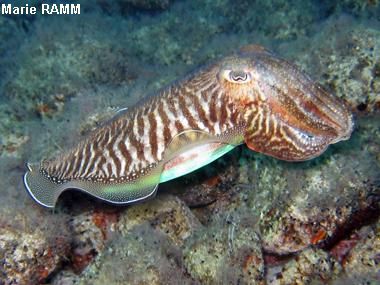| In temperate waters, maximum mantle length is 49 cm and up to 4 kg in weight. In the subtropics, maximum mantle length is 30 cm and up to 2 kg in weight (Ref. 1695). Common size: 15.0 to 25.0 cm (West Saharan fisheries; Ref. 275). One of the most important species for cephalopod fisheries in many countries but have been observed in recent years that it is heavily fished, e.g., Mediterranean (Ref. 1695). Also, a highly valued item especially in Japan, Korea, Italy and Spain (Ref. 1695). Maximum depth range from Ref. 114857. A neritic, demersal species found in the subtidal zone to depths of 200 m, generally over sandy-muddy substrates (Ref. 1695, page 100). Presence in Portuguese waters indicates its tolerance for brackish water. Undegoes seasonal migrations between inshore waters in spring and summer and medium shelf grounds (around 100 m depth) in autumn and winter. Courtship behavior is elaborate and ritualized with visual displays and 'mate guarding'. Spawns in shallow waters, optimally between 13° to 15°C. Eggs, 8 to 10, mm diameter and blackened with ink, are attached on seaweed, shells, debris and other substrates, in grape-like clusters. Depending on water temperature, eggs hatch after 30 to 90 days. Hatchlings measure about 7 to 8 mm TL. From hatchlings to adults, exhibit light-induced burying behavior where most individuals hide in sand during the day and where prey is often ambushed. Life cycle under natural conditions, between 12 to 24 months. Feeds on small molluscs, crabs, shrimps, other cuttlefishes, and juvenile demersal fishes. Cannibalism is common. Considered one of the most commercially important cephalopod species. With potential for aquaculture. Usually marketed fresh or frozen as a highly valued food item, especially in Japan, Korea, Italy and Spain (Ref. 1695). |

